Josh Darby and RUAWAKA
Words by Grant Dixon
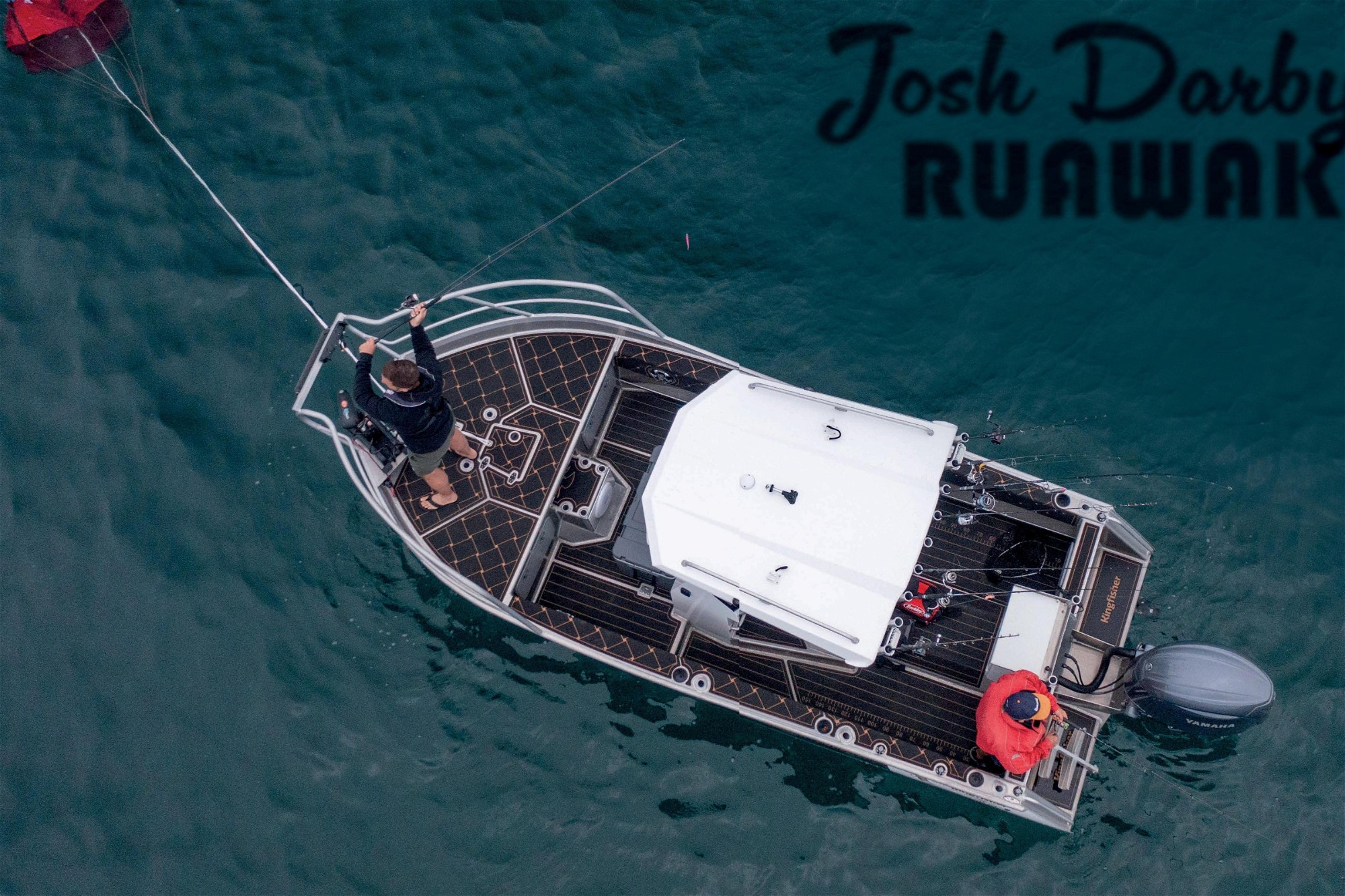
Ruawaka has been designed and fitted out specifically for lure fishing by owner Josh Darby.
Images by Sam Pillidge, Spec Media
The Bloke
When Josh Darby first dangled a line in a stream that bordered the family’s Far North camping ground, little did he realise it was the first tentative step of a life-long passion.
The campground was situated at Kaihu, a little settlement 20 minutes’ drive north of the Kai Iwi lakes. The stream created a border around the campground and in it lived Josh’s first target species, eels.
Having landed a few of the slippery critters, the young lad heard there were trout in the stream, and that kicked off an almost obsessed threeday quest to land one.
“I am told I cast for that trout for three days solid, dawn to dusk before
I had some success and landed a small trout,” Josh recalls.
What he didn’t appreciate at the time was ‘cheese’ was not on the list of legal trout baits, but it had worked fine for the eels, right?
His fishing became much more legal when joining forces with his grandparents who lived at Whangaparaoa.
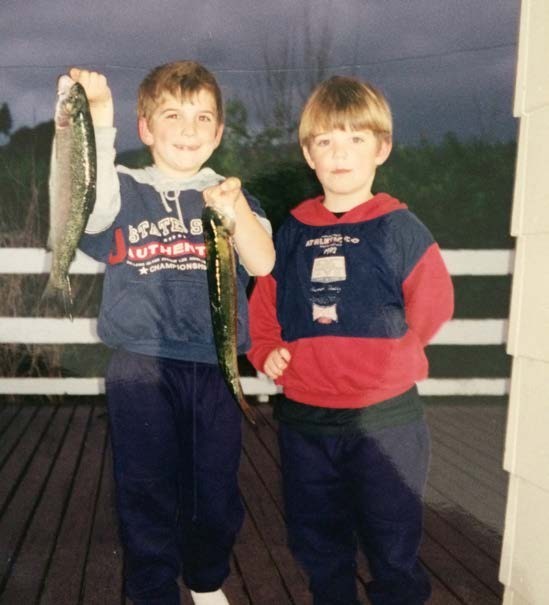
In the beginning. A very young Josh Darby and brother Sam with an early catch.

Catch and release of the bigger snapper plays a big part in Josh’s approach to his fishing.
“ GETTING THAT LURE OUT INTO THE WASH FOR A SNAPPER OR A LIKELY KINGFISH HAUNT IS A KEY COMPONENT TO MY STYLE OF FISHING, SO YOU NEED LOTS OF UNCLUTTERED SPACE. ”
“They had the quintessential Kiwi tinnie at the time from which they mainly concentrated on longlining, with line fishing helping to fill in the soak time.” But for the young angler, these were exciting times and a great introduction to what was to become his own piscatorial playground, right on his doorstep. He would stay over the night before a trip with ‘Nan and Pop’, hardly able to sleep as he anticipated what would unfold early the next morning. Bait played a big part in the family’s fishing endeavours, but that was about to change dramatically.
Today Josh is respected among the fishing community for his specialty event – lure fishing. His angling rebirth came when he met a policeman in his late teens who talked up softbaiting as the ‘new wave’ of angling and he was to be proven right. It piqued Josh’s inquiring mind and he took up the offer to go out and give it a go.
“That first trip was amazing, we caught fish after fish, and not a bait in sight.”
Josh was hooked, a fervent disciple of the new age in angling, following every word of the gurus at the time.
Mark Kitteridge and Paul Senior were writing about the subject prolifically in NZ Fishing News, giving presentations at tackle stores and fishing clubs throughout the North Island, spreading the gospel. They, along with several others such as Malcolm Dawson, were responsible for the growth in lure fishing for a whole range of species, with casting topwater lures for kingfish being added to the mix.
At the age of 18 Josh signed up with the fire service, a move which allowed him time to fulfil his fishing fix and hone his lure fishing craft.
“Our shift pattern often meant we had four free days in succession. Other firefighters had to take second jobs in their time off to make ends meet, but in those early years I didn’t have any commitments such as a family to feed or a mortgage to pay, so it was the perfect job.”
Josh was soon sharing his newfound obsession, posting his adventures on www.fishing.net. nz. It was here that Paul Senior noticed Josh and brought him into the Ocean Angler fold. He was encouraged to write for NZ Fishing News. Paul also introduced Josh to Mark Kitteridge, who, along with his cousin Eli, became his fishing ‘partners in crime’.
“I was very fortunate to fish a lot with Mark and Paul early on; two guys who were at the top of the lure fishing game. This allowed me to absorb many excellent insights quickly and, after some years, even give them a run for their money!”
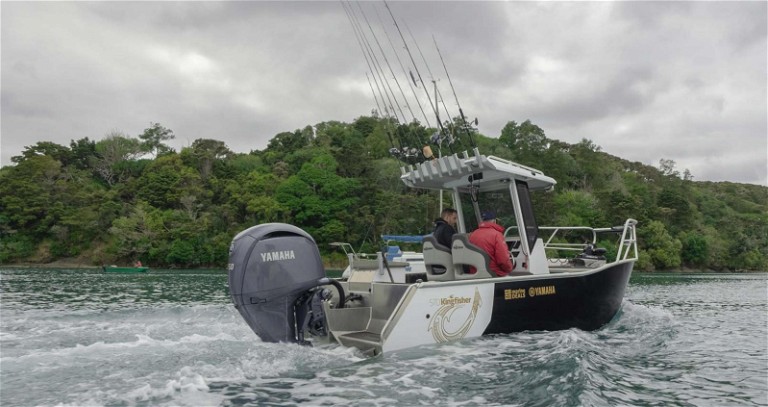
Do you think we have enough rods?
Josh has never stepped away from sharing his ‘secrets’ – his favourite spots the exception – and this has made him a popular contributor.
In recent years Josh has become one of the industry’s acknowledged experts, refining his lure fishing techniques for snapper and kingfish, much to the detriment of the wider Hauraki Gulf populations. He is busy on social media where he represents Ocean Angler, Marine Deals and most recently Kingfisher Boats and Yamaha.
Josh is still in the fire service but is currently off the trucks, working on a Movember-funded two-year project aimed at reducing suicide and psychological injury rates among first responders. While this role still allows time for fishing, this is tempered by his marriage to Tijana and their seven-month-old son Luca.
“Tijana will come fishing, but the conditions have to be flat calm and the fish on the chew.”
He cannot wait until Luca is old enough to join him out on the water, so he can pass on the mantle. The first steps have been taken, Josh has already bought him a lifejacket in anticipation of that day, but he has to get sign-off from ‘the boss’ first!
A big part of Josh’s angling endeavours involved boats, starting with the previously mentioned tinnie, which was followed by Haines Signature 5.5 trailerboat. While these got the young Josh Darby out on the water, the pursuit of his lure fishing aspiration would need a more specialised craft.
For Josh, this was a centre console, starting with an FC430 followed by a FC500 and FC535, before graduating to the Kingfisher 570 Powercat he has just put together and is the main focus of this feature.
“Centre consoles are ideal for lure fishing, especially where casting is required. Getting that lure out into the wash for a snapper or a likely kingfish haunt is a key component to my style of fishing, so you need lots of uncluttered space.”
Josh fished the centre consoles to their limit – Great Barrier and the Mokohinaus were regular haunts with occasional visits to the far Far North.
Step up the Kingfisher.
The Boat
With Josh’s previous experience in centre consoles, and a passion for lure fishing, there is little wonder that the Kingfisher 570 Powercat - appropriately christened Ruawaka - is such a well-appointed, fit-forpurpose craft.
So why a catamaran? ”Being an alloy boat, one of the first considerations was how relatively easy it was to personalise it. The second was the volume a catamaran offers – essentially useable deck space runs from the bow to the stern.
“The 570 allowed me a huge casting platform forward where, with the higher customised rails, up to three anglers can softbait from safely. There is clear space surrounding it while still retaining the benefits the centre console and bimini top offer by way of shelter from the elements.”
Josh has adapted several pool noodles which he fits over the top bow rail, making it comfortable for the anglers to lean on it. The platform is accessed via a step. If you are going to be perched up on the bow casting substantial topwater lures around, you need the platform to be as stable at rest as possible, the Kingfisher delivering on that front. Another big plus for Josh has been the hull’s seakeeping ability.
“I like to fish remote locations so the boat has to be capable of handling the rough, and I have been impressed with the boat’s performance so far.”

1) The vessel has a nine-rod rocket launcher.

2) There is plenty of room to walk around the whole boat when following a hard-running fish.

3) Josh at the helm station.
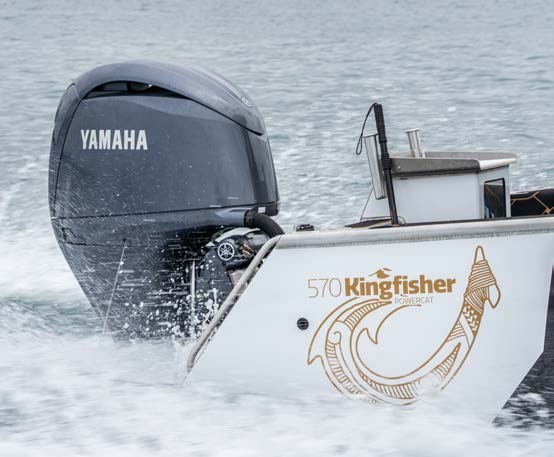
4) Yamaha provides the horsepower in a quiet, economic way.
With lure fishing comes a lot of gear, so plenty of storage is another priority for Josh. There is good space in two dry lockers under the casting platform. The port side is partially taken up by the Haswing electric motor 24-volt Lithium battery. There is more dry storage space in the centre console, with open shelving running the length of the cockpit on both sides. An open space under the seating is the perfect place for tackle bags – out of the way but still easily accessed. The boat’s conventional batteries and associated switching are stored in transom lockers, well out of the weather.
Josh carries a 120-litre ice bin forward of the centre where two crew can sit comfortably. There are two adjustable pedestal seats for the skipper and navigator who are offered good protection from the glass screen incorporated into the centre console.
While lure fishing is Josh’s go-to angling technique, a decent-sized livebait tank has pride of place built centrally into the transom. On top of it is a baitboard with a couple of rod holders on either corner.
Thanks to the hull’s beam, the centre console offers plenty of real estate available for electronics without impinging on the walkaround aspect. The showpiece is a Lowrance HDS 16” Pro plotter/ sounder run through a 1kW transom-mounted transducer. This is replicated with a slave screen fitted to the bow rail.
“I no longer need to jump down and check the helm station to see what is happening under me. I can now see all the info I need at a glance without leaving the platform.”
There is a Fusion stereo with four speakers and a sub to pump out the crew’s favourite fishing jams and a Lowrance VHF for comms.
Josh has opted for C-Zone switching which has enabled him to personalize a whole range of functionality. For example, at the push of a button the boat can be put into night mode, affecting several different functions and features.
Josh’s partnership with Marine Deals means he has been able to access a whole bunch of kit for the fitout. One example is the Scanstrut wireless mobile phone charger. Being involved in social media, much of the material Josh produces is done via his phone. The Scanstrut ensures it is always charging while being held firmly in place.
If there is one thing that is a given among lure fishers, it is the need for a range of tackle. Josh has 23 rod holders around Ruawaka – two on the casting platform, four on the step-up, two on the bait board, nine on the rocket launcher and three in either gunwale. The latter sees drink holders placed adjacent to them – a great place to put lures when travelling from spot to spot, not to mention keep the refreshments upright!
At either end are two propulsion units. Josh says for wash fishing the Haswing electric motor is invaluable. It gives me the ability to navigate quietly along the coastline while maintaining optimal casting distance regardless of wind and current direction, giving me quite an advantage.”

5) Plenty of real estate for the instrumentation.

6) The business end – a three-angler capable casting platform.
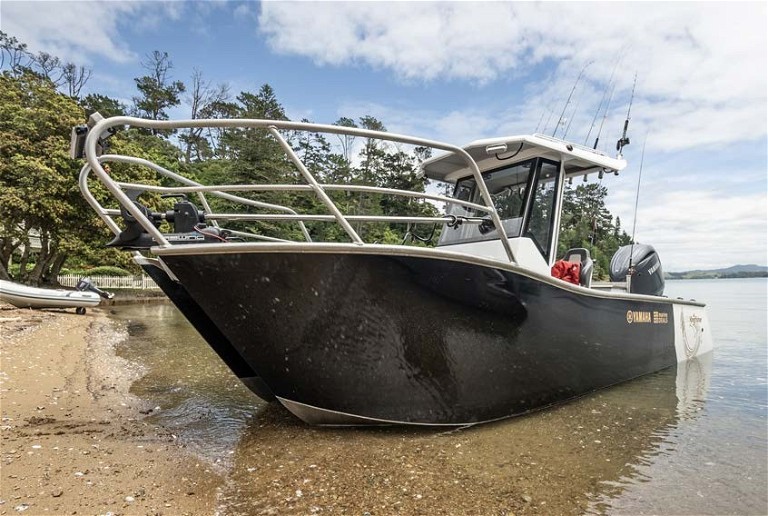
7) The bow rail has been customised to maximise casting platform support.
At the other end is a single Yamaha 150 XCB, the latest model which has integrated hydraulic steering. This leaves the transom uncluttered without the need for steering cables and the like – all very tidy. The outboard is paired with Yamaha’s 6x9 digital ‘fly by wire’ remote, which unlocks features such as pattern shift, auto trim and speed control– all enhancing the on-water experience. Josh has been impressed with the fuel economy. The boat has a top speed of around 35 knots and he generally cruises at around 20 knots, giving him a fuel burn of approximately 22 litres an hour. With 150 litres of fuel underfloor, this gives him a great range.
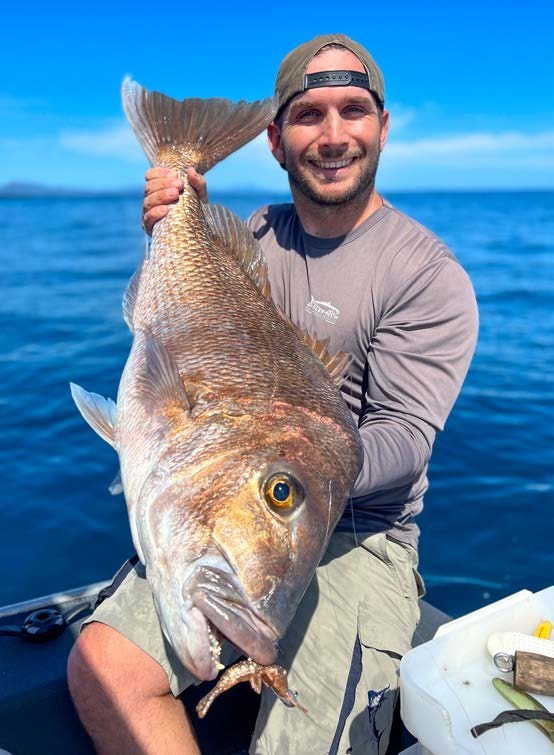
There are a few creature comforts on board, the single most obvious one being the U-Dek flooring. This is soft underfoot as well as providing excellent grip. Another is the washdown hose, always handy for keeping the work areas clean.
The vessel is well lit with Narva lighting illuminating the deck, under the gunwales, nav lights, and the transom underwater. A forward-facing light bar is set into the bow where it can illuminate the way forward without producing any deck glare.
Overall impressions
I had been following the progress of this build with great interest, in anticipation of the day we could do the review.
I was impressed by the boat’s performance and specification, it is one of those units that has a wow factor while still being eminently fishable. This is the third or fourth Kingfisher Powercat model I have reviewed and I get the catamaran’s advantages, which are many. Sure, it takes a while to come to terms with how a catamaran hull drives, but once you get your head around this it is plain sailing.
This test in the placid waters around Kawau Island did not allow us to fully utilise the boat’s many features, something I am looking to do in the future. In the meantime, you can follow Josh’s angling adventures in Ruawaka on Instagram – @joshdarbyfishing
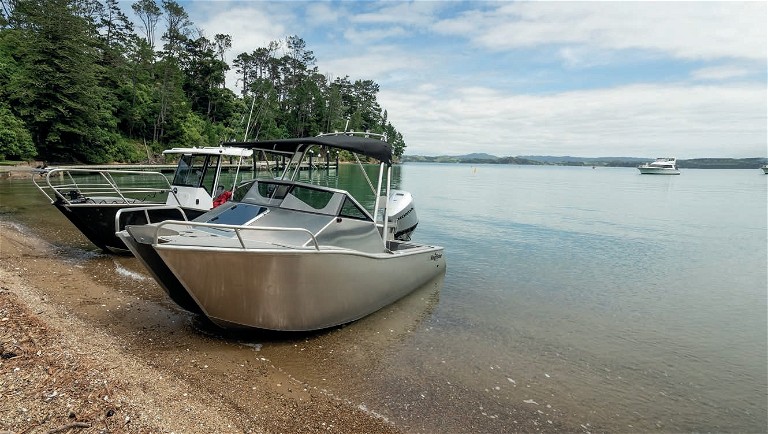
The Kingfisher 510 Powercat was our photo boat.
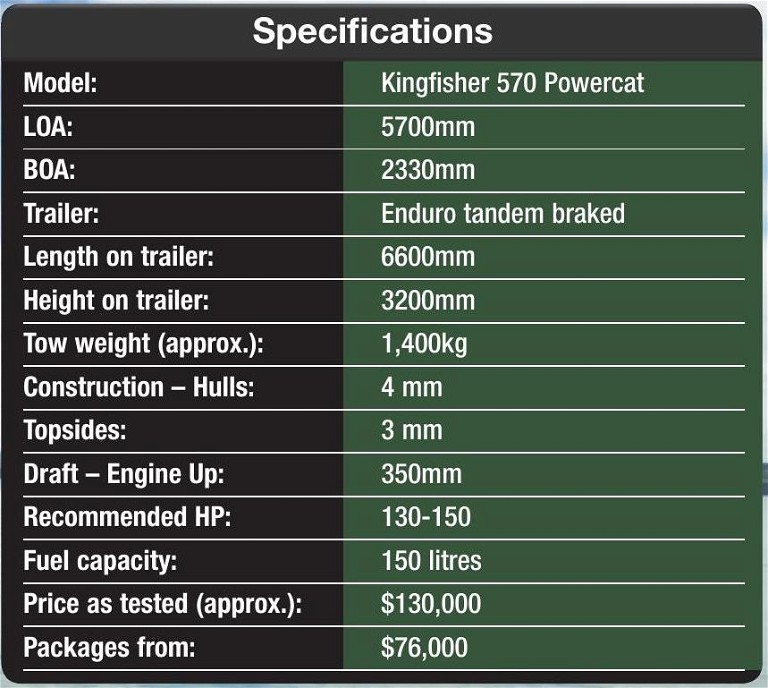
Acknowledgement
Undertaking one of these reviews effectively requires two boats. Thanks to Matt at Mangawhai Marine, Northland’s Kingfisher dealership, for bringing along and helming the photoshoot boat, another great Powercat model, the 510.
This one was configured a little differently in that it was a cuddy version, offering just that little bit more shelter and comfort without affecting its performance.
The boat is currently available for sea trials and sale at Mangawhai Marine. Check them out at: www.mangawhaimarine.co.nz